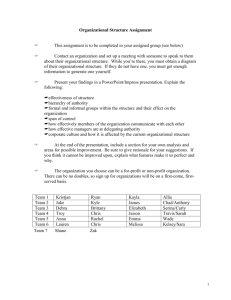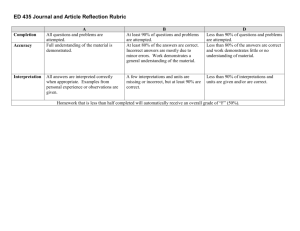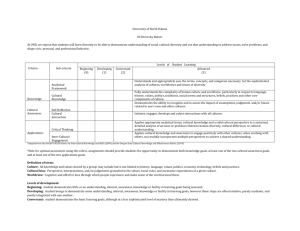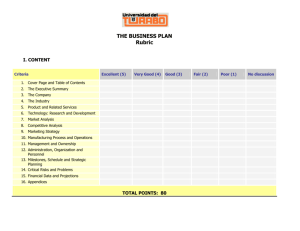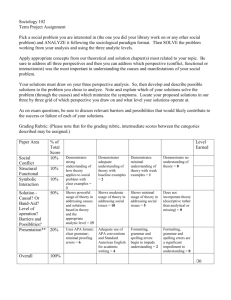Group Presentation
advertisement
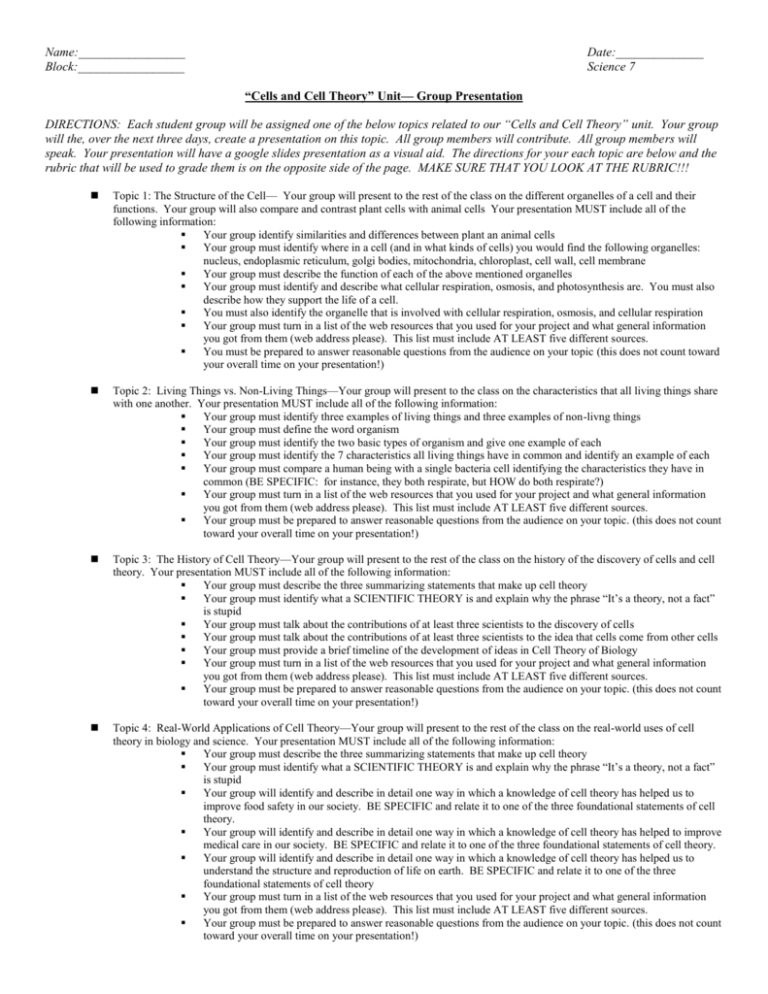
Name:_________________ Block:_________________ Date:______________ Science 7 “Cells and Cell Theory” Unit— Group Presentation DIRECTIONS: Each student group will be assigned one of the below topics related to our “Cells and Cell Theory” unit. Your group will the, over the next three days, create a presentation on this topic. All group members will contribute. All group members will speak. Your presentation will have a google slides presentation as a visual aid. The directions for your each topic are below and the rubric that will be used to grade them is on the opposite side of the page. MAKE SURE THAT YOU LOOK AT THE RUBRIC!!! Topic 1: The Structure of the Cell— Your group will present to the rest of the class on the different organelles of a cell and their functions. Your group will also compare and contrast plant cells with animal cells Your presentation MUST include all of the following information: Your group identify similarities and differences between plant an animal cells Your group must identify where in a cell (and in what kinds of cells) you would find the following organelles: nucleus, endoplasmic reticulum, golgi bodies, mitochondria, chloroplast, cell wall, cell membrane Your group must describe the function of each of the above mentioned organelles Your group must identify and describe what cellular respiration, osmosis, and photosynthesis are. You must also describe how they support the life of a cell. You must also identify the organelle that is involved with cellular respiration, osmosis, and cellular respiration Your group must turn in a list of the web resources that you used for your project and what general information you got from them (web address please). This list must include AT LEAST five different sources. You must be prepared to answer reasonable questions from the audience on your topic (this does not count toward your overall time on your presentation!) Topic 2: Living Things vs. Non-Living Things—Your group will present to the class on the characteristics that all living things share with one another. Your presentation MUST include all of the following information: Your group must identify three examples of living things and three examples of non-livng things Your group must define the word organism Your group must identify the two basic types of organism and give one example of each Your group must identify the 7 characteristics all living things have in common and identify an example of each Your group must compare a human being with a single bacteria cell identifying the characteristics they have in common (BE SPECIFIC: for instance, they both respirate, but HOW do both respirate?) Your group must turn in a list of the web resources that you used for your project and what general information you got from them (web address please). This list must include AT LEAST five different sources. Your group must be prepared to answer reasonable questions from the audience on your topic. (this does not count toward your overall time on your presentation!) Topic 3: The History of Cell Theory—Your group will present to the rest of the class on the history of the discovery of cells and cell theory. Your presentation MUST include all of the following information: Your group must describe the three summarizing statements that make up cell theory Your group must identify what a SCIENTIFIC THEORY is and explain why the phrase “It’s a theory, not a fact” is stupid Your group must talk about the contributions of at least three scientists to the discovery of cells Your group must talk about the contributions of at least three scientists to the idea that cells come from other cells Your group must provide a brief timeline of the development of ideas in Cell Theory of Biology Your group must turn in a list of the web resources that you used for your project and what general information you got from them (web address please). This list must include AT LEAST five different sources. Your group must be prepared to answer reasonable questions from the audience on your topic. (this does not count toward your overall time on your presentation!) Topic 4: Real-World Applications of Cell Theory—Your group will present to the rest of the class on the real-world uses of cell theory in biology and science. Your presentation MUST include all of the following information: Your group must describe the three summarizing statements that make up cell theory Your group must identify what a SCIENTIFIC THEORY is and explain why the phrase “It’s a theory, not a fact” is stupid Your group will identify and describe in detail one way in which a knowledge of cell theory has helped us to improve food safety in our society. BE SPECIFIC and relate it to one of the three foundational statements of cell theory. Your group will identify and describe in detail one way in which a knowledge of cell theory has helped to improve medical care in our society. BE SPECIFIC and relate it to one of the three foundational statements of cell theory. Your group will identify and describe in detail one way in which a knowledge of cell theory has helped us to understand the structure and reproduction of life on earth. BE SPECIFIC and relate it to one of the three foundational statements of cell theory Your group must turn in a list of the web resources that you used for your project and what general information you got from them (web address please). This list must include AT LEAST five different sources. Your group must be prepared to answer reasonable questions from the audience on your topic. (this does not count toward your overall time on your presentation!) GRADING RUBRIC: EXCELLENT (20) Presentation substantively addresses every bullet point in the project description. GOOD (16) Presentation substantively addresses all but one bullet point in the project description. MEDIOCRE (13) Presentation substantively addresses all but two bullet point in the project description. POOR (10) Presentation fails to substantively address several of the bullet points in the project description. SCIENTIFIC ACCURACY Presentation includes NO scientific inaccuracies in its information (this includes the question and answer session at the end!) Presentation includes 1-2 scientific inaccuracies in its information (this includes the question and answer session at the end!) Presentation includes 3-4 scientific inaccuracies in its information (this includes the question and answer session at the end!) Presentation includes 5 or more scientific inaccuracies in its information (this includes the question and answer session at the end!) VISUAL AID Visual aid includes ALL of the following: Visual aid includes THREE of the following: Visual aid includes TWO of the following: Presentation meets less than TWO of the requirements - There is a visual aid - The visual aid is on-topic and related to what students are talking about - The visual aid is actually used to help explain; it’s not just a background of text to be read -The visual aid includes some elements of interaction with the audience - There is a visual aid - The visual aid is on-topic and related to what students are talking about - The visual aid is actually used to help explain; it’s not just a background of text to be read -The visual aid includes some elements of interaction with the audience - There is a visual aid - The visual aid is on-topic and related to what students are talking about - The visual aid is actually used to help explain; it’s not just a background of text to be read -The visual aid includes some elements of interaction with the audience Presentation demonstrates ALL of the following: Presentation demonstrates THREE of the following: Presentation demonstrates TWO of the following: - Neat, organized visual aids - All group members participating - Group members seem, wellprepared and knowledgeable about their topic -An attempt to “go beyond” the requirements of the assignment; demonstrates some level of ambition; does more than simply “follow the rubric” - Neat, organized visual aids - All group members participating - Group members seem, well-prepared and knowledgeable about their topic -An attempt to “go beyond” the requirements of the assignment; demonstrates some level of ambition; does more than simply “follow the rubric” - Neat, organized visual aids - All group members participating - Group members seem, well-prepared and knowledgeable about their topic -An attempt to “go beyond” the requirements of the assignment; demonstrates some level of ambition; does more than simply “follow the rubric” Presentation is 5 minutes or longer (maximum 8 minutes long) Presentation is 4 minutes or longer Presentation is 3 minutes or longer ON-TOPIC CREATIVITY/ EFFORT/ PARTICIPATION LENGTH OF PRESENTATION Presentation meets less than TWO of the requirements Presentation is less than three minutes long.
